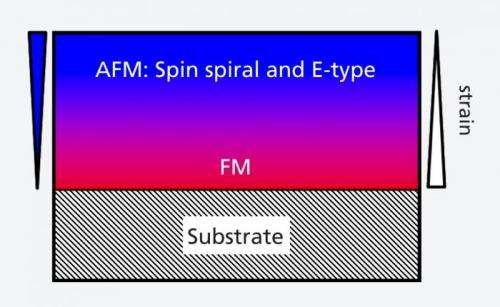Diagram of the processes in the LuMnO3 layers studied. The layer is especially strained close to the substrate, which leads to a ferromagnetic order there. As the distance grows, the strain decreases so that two antiferromagnetic orders appear: the spin spirals and the E-type, where two spins point in one direction and the next two in the other.
(Phys.org) —Researchers from the Paul Scherrer Institute (PSI) have made thin, crystalline layers of the material LuMnO3 that are both ferromagnetic and antiferromagnetic.
These layers were grown on a non-magnetic carrier crystal. The LuMnO3 layer is ferromagnetic directly next to the interface with the carrier crystal. As the distance increases, it assumes the material's normal antiferromagnetic order while the ferromagnetism steadily becomes weaker. The ferromagnetism occurs because LuMnO3 adapts to the structure of the carrier crystal as the layers grow. This leads to distortions in the crystalline structure of LuMnO3, where the now partly ferromagnetic order is preferred. Layered structures with different magnetic orders are already used in various electronic devices today. The possibility of producing two different magnetic orders within a material could thus be of great technical importance for highly compact digital storage media or sensor technology. The LuMnO3 layers were produced and studied at the PSI – including with neutrons and muons at the institute's large-scale facilities. The results were published in the journal Physical Review Letters.
Electronic components made of several layers with different magnetic orders are frequently used in various devices – such as in read heads for hard drives, which read the data stored, or in highly sensitive magnetic field sensors, which are read electrically. Researchers from the Paul Scherrer Institute (PSI) have now found a material that combines different magnetic properties. The material used is lutetium manganese oxide, which has a perovskite structure, much like high-temperature superconductors. The thin, single crystalline layers were grown on a non-magnetic, single crystalline carrier crystal (YAlO3).
Distortion makes opposing orders possible
Normally, single crystalline LuMnO3 exhibits an antiferromagnetic order where two spins always point in one and the next two in the opposite direction. In the layers produced and studied at the PSI, instead a ferromagnetic order, where all spins point in the same direction, was observed in the first ten nanometres, i.e. in the direct vicinity of the surface of the carrier crystal. "Normally, you can't convert an antiferromagnet into a ferromagnet – for reasons of symmetry apart from anything else. Something special must have happened here," stresses Christof Schneider, one of the researchers involved. The most likely explanation for the effect is that the crystal structure of the material becomes distorted because it adapts to the structure of the carrier crystal. The ferromagnetic order is preferred in the distorted structure. The crystalline structure relaxes somewhat as the distance to the base increases but not completely, meaning that the expected antiferromagnetic order should appear from a certain distance. Instead, an antiferromagnetic spin spiral is observed where the spins are arranged in the form of a spiral staircase.
Experiments with neutrons to study the magnetic structure on LuMnO3 clearly indicate these spin spirals. The measurement results suggest that there is also the expected antiferromagnetic order. "To unravel the mystery of the magnetism in the thin films, we realised that we had to apply multiple neutron scattering techniques. Particularly crucial were novel neutron reflectivity measurements which allowed us to identify the exact location of ferromagnetism." says Christof Niedermayer, who conducted part of the neutron experiments.
Wide-ranging expertise at the PSI
The expertise of various labs at the PSI contributed to the result. The layers studied were produced in the materials workgroup in the Department of General Energy using laser ablation. The raw material vaporised with the laser was deposited on a heated, single crystal YAlO3 base to enable a single crystalline layer to form. The magnetic properties were studied at the PSI's large-scale facilities with the aid of neutrons and muons. The major advantage here is that neutrons and muons have a magnetic moment and thus provide a detailed insight into the magnetic structure of the materials, which enabled the ferromagnetic components to be localised within the layers using neutron reflectometry, for instance.
The collaboration between the different labs is supported by PSI's internal promotional instruments: the internal research commission and the CROSS programme, which promotes collaboration between different research areas of the institute. Furthermore, it is backed by the Swiss National Science Foundation (SNSF) under the MaNEP programme for researching materials with novel electrical properties.
More information: DOI: 10.1103/PhysRevLett.111.037201
Journal information: Physical Review Letters
Provided by Paul Scherrer Institute






















